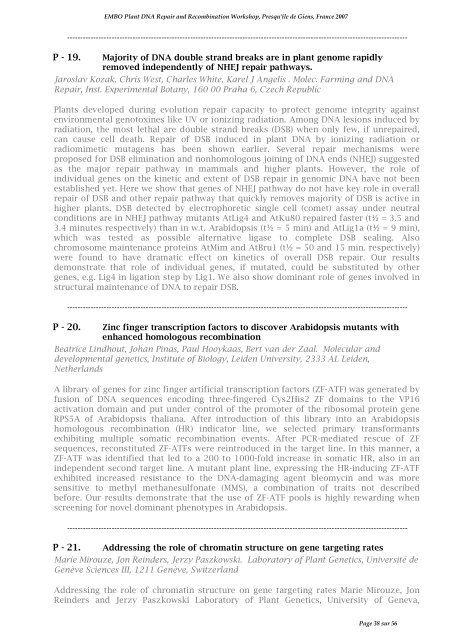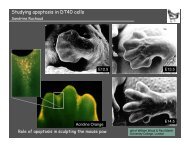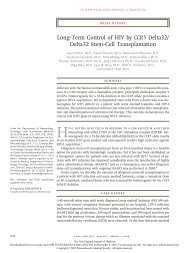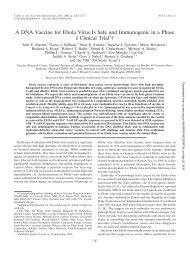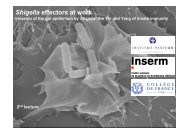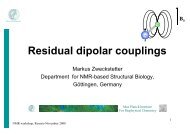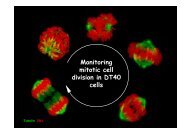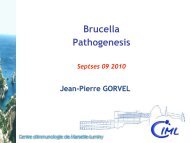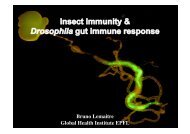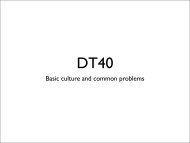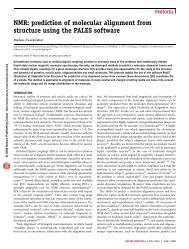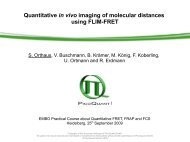pdf file - Events - EMBO
pdf file - Events - EMBO
pdf file - Events - EMBO
You also want an ePaper? Increase the reach of your titles
YUMPU automatically turns print PDFs into web optimized ePapers that Google loves.
<strong>EMBO</strong> Plant DNA Repair and Recombination Workshop, Presqu'île de Giens, France 2007<br />
----------------------------------------------------------------------------------------------------------------------------------<br />
P - 19. Majority of DNA double strand breaks are in plant genome rapidly<br />
removed independently of NHEJ repair pathways.<br />
Jaroslav Kozak, Chris West, Charles White, Karel J Angelis . Molec. Farming and DNA<br />
Repair, Inst. Experimental Botany, 160 00 Praha 6, Czech Republic<br />
Plants developed during evolution repair capacity to protect genome integrity against<br />
environmental genotoxines like UV or ionizing radiation. Among DNA lesions induced by<br />
radiation, the most lethal are double strand breaks (DSB) when only few, if unrepaired,<br />
can cause cell death. Repair of DSB induced in plant DNA by ionizing radiation or<br />
radiomimetic mutagens has been shown earlier. Several repair mechanisms were<br />
proposed for DSB elimination and nonhomologous joining of DNA ends (NHEJ) suggested<br />
as the major repair pathway in mammals and higher plants. However, the role of<br />
individual genes on the kinetic and extent of DSB repair in genomic DNA have not been<br />
established yet. Here we show that genes of NHEJ pathway do not have key role in overall<br />
repair of DSB and other repair pathway that quickly removes majority of DSB is active in<br />
higher plants. DSB detected by electrophoretic single cell (comet) assay under neutral<br />
conditions are in NHEJ pathway mutants AtLig4 and AtKu80 repaired faster (t½ = 3.5 and<br />
3.4 minutes respectively) than in w.t. Arabidopsis (t½ = 5 min) and AtLig1a (t½ = 9 min),<br />
which was tested as possible alternative ligase to complete DSB sealing. Also<br />
chromosome maintenance proteins AtMim and AtBru1 (t½ = 50 and 15 min. respectively)<br />
were found to have dramatic effect on kinetics of overall DSB repair. Our results<br />
demonstrate that role of individual genes, if mutated, could be substituted by other<br />
genes, e.g. Lig4 in ligation step by Lig1. We also show dominant role of genes involved in<br />
structural maintenance of DNA to repair DSB.<br />
----------------------------------------------------------------------------------------------------------------------------------<br />
P - 20. Zinc finger transcription factors to discover Arabidopsis mutants with<br />
enhanced homologous recombination<br />
Beatrice Lindhout, Johan Pinas, Paul Hooykaas, Bert van der Zaal. Molecular and<br />
developmental genetics, Institute of Biology, Leiden University, 2333 AL Leiden,<br />
Netherlands<br />
A library of genes for zinc finger artificial transcription factors (ZF-ATF) was generated by<br />
fusion of DNA sequences encoding three-fingered Cys2His2 ZF domains to the VP16<br />
activation domain and put under control of the promoter of the ribosomal protein gene<br />
RPS5A of Arabidopsis thaliana. After introduction of this library into an Arabidopsis<br />
homologous recombination (HR) indicator line, we selected primary transformants<br />
exhibiting multiple somatic recombination events. After PCR-mediated rescue of ZF<br />
sequences, reconstituted ZF-ATFs were reintroduced in the target line. In this manner, a<br />
ZF-ATF was identified that led to a 200 to 1000-fold increase in somatic HR, also in an<br />
independent second target line. A mutant plant line, expressing the HR-inducing ZF-ATF<br />
exhibited increased resistance to the DNA-damaging agent bleomycin and was more<br />
sensitive to methyl methanesulfonate (MMS), a combination of traits not described<br />
before. Our results demonstrate that the use of ZF-ATF pools is highly rewarding when<br />
screening for novel dominant phenotypes in Arabidopsis.<br />
----------------------------------------------------------------------------------------------------------------------------------<br />
P - 21. Addressing the role of chromatin structure on gene targeting rates<br />
Marie Mirouze, Jon Reinders, Jerzy Paszkowski. Laboratory of Plant Genetics, Université de<br />
Genève Sciences III, 1211 Genève, Switzerland<br />
Addressing the role of chromatin structure on gene targeting rates Marie Mirouze, Jon<br />
Reinders and Jerzy Paszkowski Laboratory of Plant Genetics, University of Geneva,<br />
Page 38 sur 56


